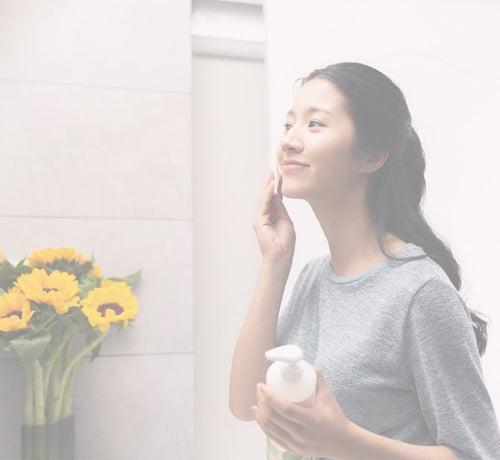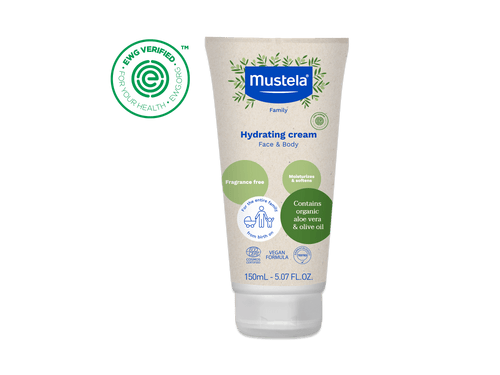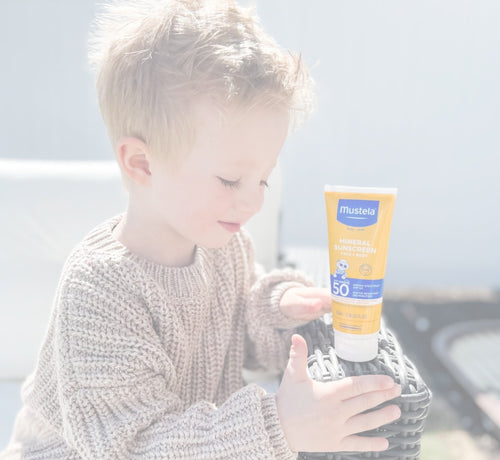If you’ve been searching for sunscreen ingredients that are safe for the whole family, you might have come across the term “non-nano zinc oxide” multiple times before. But what does it mean? And more importantly, what makes it so special?
You’re asking all the right questions!
In this article, we’ll dive deep into what non-nano zinc oxide is, how it works, and some products (sunscreen as well as diaper cream!) you can find that are formulated with this incredible mineral.
Let’s get started!
Table Of Contents
- Benefits Of Choosing The Right Sunscreen
- What Is Zinc Oxide?
- What Is Non-Nano Zinc Oxide?
- Other Natural Sunscreen Ingredients
- Sunscreen Ingredients To Avoid
- Sunscreens With Non-Nano Zinc Oxide
- Sun Safety
- Diaper Creams With Non-Nano Zinc Oxide
- Non-Nano Zinc Oxide For The Win!
Benefits Of Choosing The Right Sunscreen

Most of us wear sunscreen regularly without thinking too much about it. It has just become a part of our routine.
Before we talk about non-nano zinc oxide, the different types of sunscreen, and why ingredients matter, let’s take a minute to look at why wearing the right sunscreen is important in the first place.
1) Prevents Premature Aging
Having radiant and healthy-looking skin is something everyone wants. Luckily, sunscreen helps your skin stay youthful-looking for longer! By protecting you from the harmful rays of the sun, sunscreen prevents your skin from developing early wrinkles and fine lines.
Studies have also found that people under the age of 55 who wore sunscreen daily had 24% less skin aging compared to people who only wore sunscreen occasionally.
2) Lowers Your Chances Of Developing Skin Cancers
When you wear sunscreen on a daily basis, you lower your risk of developing different types of skin cancers, especially melanoma.
Melanoma begins in your skin cells and controls the pigmentation of your skin. It can also extend from the surface to deeper layers of your skin.
The more you wear sun protection every day the fewer chances you have of developing this and many other cancers.
3) Prevents Sunburn

Prevention against sunburn is probably one of the most common reasons why people wear sunscreen. No one wants red, hot, and uncomfortable skin.
As long as you wear your mineral sunscreen while you’re outside and keep reapplying every couple of hours, you won’t have to worry about this!
Just remember that the risk of sunburn isn’t the only reason to wear sunscreen. As we mentioned, over time, sun exposure can leave you at risk for premature aging and skin cancer.
This is one reason it’s important to wear sunscreen daily rather than only on beach or pool days.
4) Prevents Skin Rashes And Other Irritations
Have you ever worn sunscreen and immediately developed a reaction to the product? That usually happens with chemical sunscreens, which contain a lot of harsh chemicals.
Mustela’s sunscreens, on the other hand, are formulated with naturally derived ingredients, dermatologist-tested, and National Eczema Association (NEA) approved!
As you can see, sunscreens are not all created equal, and that’s why you’ll want to choose a safe, effective sunscreen made with non-nano zinc oxide.
That brings us to the next point. What exactly is zinc oxide?
What Is Zinc Oxide?

Now that we’ve covered why wearing sunscreen is important, it’s time to talk specifics!
Firstly, zinc oxide is a mineral that has a long history of being used in sun protection products. That’s because it is incredibly effective in protecting you from both UVA and UVB rays.
Zinc oxide is one of the main active ingredients in mineral sunscreens (more on this shortly). If you’re not familiar with the term “active ingredients,” it simply refers to the ingredients that accomplish the goal of the product — in this case, warding off the sun’s rays.
Because of how effective it is — especially when it comes to your skin — zinc oxide can be found in lots of other skincare products, too.
This mineral has been used to treat multiple skin conditions, including eczema, acne, and even burn wounds. It supports healing by soothing, softening, and adding moisture to the skin.
If you have kids, you may have also seen the ingredient listed on the back of your baby’s diaper cream label.
The fact that zinc oxide can be found in so many skincare products goes to show just how effective it is in helping you care for your skin!
Speaking about caring for your skin, sometimes sunscreens (and other skincare products) contain harmful ingredients. That’s why it’s important to ensure that your products contain non-nano zinc oxide.
What Is Non-Nano Zinc Oxide?

In order to fully grasp what non-nano zinc oxide is, we first need to understand the term “nano.”
Nano refers to nanometers. It is a unit of measurement for length in the metric system, and one nanometer is equal to one-billionth of a meter. Nanoparticles are smaller than 100 nanometers.
Since “nano” refers to super-small particles, “non-nano” is, therefore, not as small. These are larger than 100 nanometers.
So, if nano and non-nano zinc oxide are all about size, what does this have to do with your sun protection?
Before we can answer that question, we need to look at the different types of sunscreen. If you’ve been reading our blog for a while, you’ll know how much we advocate for mineral sunscreen over chemical sunscreen.
In a nutshell, mineral sunscreen is better for you and the environment because of the ingredients used. More on that soon.
There are two main active ingredients in mineral sunscreen: zinc oxide and titanium dioxide. And mineral sunscreens can have either (or both) nano and non-nano zinc oxide particles.
When it comes to sun protection, the bigger the particle size the better. Why?
Because of the way nanoparticles act on your skin. When you apply sunscreen with nano zinc oxide, the super-small particles can penetrate your skin cells and end up in your bloodstream (and even in your lungs).
In addition, if you’re planning to enjoy a day at the beach, the coral reefs can also ingest these tiny particles when the sunscreen washes off in the ocean.
Studies are still ongoing about the full dangers that nanoparticles can have on our skin and the environment. But in the meantime, we think it’s important to stay safe, which is why we prefer non-nano zinc oxide and have included it in all our sunscreens.
These particles are too large to be absorbed by your skin, making them safe for the whole family.
Other Natural Sunscreen Ingredients

When it comes to the active ingredients in your sunscreen, opt for non-nano zinc oxide and titanium dioxide. That said, it’s worth paying attention to the inactive ingredients as well so you can treat your and your family’s skin to a soothing, hydrating sunblock that’s oh-so-gentle.
Look for a sunscreen with natural ingredients, such as:
- Coconut oil
- Vitamin E
- Macadamia oil
- Shea butter
- Chamomile flower extract
- Avocado oil
- Sunflower seed oil
- Jojoba
- Aloe vera
- Calendula
Sunscreen Ingredients To Avoid
As a sunscreen ingredient, non-nano zinc oxide gets a 10 out of 10 (and the go-ahead from us), as do the other natural ingredients we mentioned.
But in order to help you choose a safe, effective, and gentle sunscreen for your whole family, we want to discuss a few of the not-so-great ingredients (both active and inactive) that you should avoid.
Active Ingredients

We mentioned that there are two types of sunscreen: chemical and mineral. Non-nano zinc oxide belongs to the mineral category.
While mineral sunscreens work by reflecting and deflecting the sun’s rays, chemical sunscreens work through a chemical reaction, absorbing the rays when they hit your skin.
We recommend staying away from the active ingredients in chemical sunscreens, which include:
- Octinoxate
- Oxybenzone
- Avobenzone
- Homosalate
- Octisalate
- Octocrylene
But if these ingredients keep you from getting a sunburn or sun damage, why are they a bad deal? Because they can irritate your skin, especially for those with sensitive skin.
That’s significant, but it’s not all there is. These ingredients can also seep into your body via your skin.
When oxybenzone finds its way into your body, it can disrupt hormones. And, in addition to ending up in your bloodstream, trace amounts of these chemical ingredients can even make it into breast milk.
In fact, a study found trace amounts of at least one sunscreen chemical in the breast milk of 76.5% of the women they tested.
As you can imagine, we think it’s better safe than sorry when it comes to these types of ingredients. So, we avoid them altogether.
Inactive Ingredients

All sorts of inactive ingredients — the ones that make up the scent and texture, for example — can be found in both mineral and chemical sunscreens. And some of them aren’t that kind to your skin or your body.
Synthetic Fragrances
Synthetic fragrances are typically found on the ingredient list as “fragrance” or “parfum.” The catch is that a lot of different chemicals can hide in this one ingredient, and many people find that synthetic fragrances irritate their skin.
Speaking of fragrances, did you know that “fragrance-free” is not the same as “unscented?” Read about the difference between them here.
Parabens
Parabens function as a preservative and are used in all sorts of cosmetics and toiletries, from shampoo and sunscreen to lipstick and eyeliner. The problem is that parabens can mimic estrogen, and this could affect your health or your unborn baby’s fetal development.
Phthalates
You might be surprised to learn that this ingredient is used in cosmetics, but it’s also used to make plastics more flexible and durable. For skincare products, phthalates serve to enhance the scent or make products less stiff.
The dark potential of this ingredient? There is concern that it may act as an endocrine disruptor, contribute to neurodevelopmental disorders in children, and lead to asthma and allergies.
Phenoxyethanol
Phenoxyethanol is another ingredient that is used as a preservative. But it can irritate your skin, too. Find out how by clicking here.
Sunscreens With Non-Nano Zinc Oxide
Now that we’re on the same page about the importance of non-nano zinc oxide in your sun protection, where can you find sunscreens that have this ingredient and don’t include the questionable chemical ingredients?
Here are three sunscreens that fit the bill so you can take your pick.
SPF 50 Mineral Sunscreen Lotion

If you’re looking for something safe and effective for both you and your family, Mustela’s SPF 50 Mineral Sunscreen Lotion ticks all the right boxes!
This sunscreen is not only non-nano, but it’s also formulated from 93% naturally derived ingredients, which include vitamin E, coconut oil, and macadamia oil.
This product is also safe to use on your little one from birth. And the natural ingredients make it perfect for people with sensitive skin!
SPF 30 Mineral Sunscreen Spray

If you prefer the ease of spray sunscreen over lotion, then you’ll love Mustela’s SPF 30 Mineral Sunscreen Spray. It contains non-nano zinc oxide, too, and is water-resistant for up to 80 minutes.
That makes it great for those pool or beach days when you just can’t keep away from the water!
Some people may shy away from mineral sunscreen because most leave a white residue on the skin. Not this one! Our mineral sunscreen is lightweight and sheer.
As a bonus, our spray contains natural ingredients such as aloe vera, sunflower oil, and calendula.
These gentle and natural ingredients give the product soothing and hydrating properties to make your skin feel amazing while being protected from the sun!
SPF 50 Mineral Sunscreen Stick

Finally, Mustela’s SPF 50 Mineral Sunscreen Stick offers sun protection for you, your little ones, and the whole family.
Besides loving its non-nano zinc oxide and 70% organic materials (including shea butter, avocado oil, sunflower seed oil, and jojoba), you’ll love how travel-friendly it is. You can quickly put this in any size bag to ensure that you and your family will get the sun protection you need!
And with the National Science Foundation (NSF) quality seal, the acceptance by the National Eczema Association (NEA), and our rigorous pediatric and dermatological testing, you can rest assured that our Mineral Sunscreen Stick contains organic ingredients and is free of harsh chemicals.
Safe For Your Family And The Environment
We highlighted above some of the dangers that chemical sunscreens can pose to your family as well as the environment.
The good news is that all of our sunscreens are compliant with Hawaii’s sunscreen ingredient requirements — because we love to have fun in the sun without harming the ocean!
By now, you’ve also probably noticed a few common themes between our sunscreens:
- They all contain non-nano zinc oxide
- They are safe for the whole family and the environment
- They are formulated with gentle, naturally derived ingredients and are certified by NEA, making them great for people with sensitive skin
Our sunscreens are also developed in collaboration with healthcare professionals and based on scientific research. With all these qualities, you can’t go wrong with Mustela’s sun protection products!
Sun Safety
We’ve talked about non-nano zinc oxide, and, as you’ve read in this article, the right sunscreen is essential. But as important as frequent sunscreen application is, it shouldn’t be your only sun protection. Smart sun safety is key!
When possible, avoid the peak hours, which are typically 10:00 am to 2:00 pm, but you can check the UV index in your area. For all-day outdoor adventures, aim for an inside lunch break or a rest under a sun umbrella during peak hours.
Wearing the right clothing is another way to protect yourself and your family. This can include sunglasses, hats (wide-brimmed to protect your ears, too!), short- or long-sleeved shirts, or a breezy skirt.
Diaper Creams With Non-Nano Zinc Oxide

On this journey of learning about sunscreens, you may have come to realize that non-nano zinc oxide is a stellar skincare ingredient for everyone in the family.
Before we wrap up, we want to mention two diaper cream options that allow you to treat your baby’s bum to zinc oxide and other natural ingredients.
Diaper Rash Cream 1 2 3
Our best-selling Diaper Rash Cream 1 2 3 is a 3-in-1 product that prevents diaper rash and relieves and recovers your baby's delicate skin at every diaper change. And it continues to work in-between diaper changes to prevent future rashes.
Composed of 98% plant-based ingredients, this product is clinically proven to soothe your little one’s diaper area and relieve irritation and redness.
Sunflower oil distillate works to repair the skin barrier, oxeoline of alcacea soothes your baby’s skin, and zinc oxide creates a comfortable, protective barrier.
This diaper cream also contains a patented, natural ingredient called avocado perseose that’s specifically designed to help protect a baby’s delicate diaper area.
Our special ingredient helps develop the skin's barrier function by strengthening protein and lipid production. It also protects the cell capital found in the underdeveloped skin of young children.
In addition to counting on all of these natural ingredients, rest assured that this diaper cream is hypoallergenic and free of parabens, phthalates, and phenoxyethanol.
All you have to do is apply this cream as often as needed with every diaper change, especially at bedtime or after prolonged exposure to a wet diaper.
Diaper Cream With Olive Oil And Aloe

The second non-nano zinc oxide diaper cream we’ll mention is our Diaper Cream with Olive Oil and Aloe.
If you’re a fan of organic ingredients, this pediatrician-tested diaper cream is the one for your baby. With 97% naturally derived ingredients, this cream is made with organic aloe vera, olive oil, and sunflower seed oil.
The olive oil we use in this product is sourced from family-owned groves in the South of France, and the olives undergo a cold-pressed extraction process to maximize potency and skin-nourishing properties.
We leave no leaf unturned when it comes to the quality of our skincare products!
Plus, this diaper cream is good for your baby’s skin and the earth, too. It’s environmentally conscious inside and out with a recyclable bottle, packaging made from sustainably sourced materials, and no secondary cartons.
We’re proud to say that it meets EWG Verified™ criteria, which means it avoids EWG's ingredients of concern. Our easy-to-apply, dye, fragrance, and talc-free formula is safe for even the most sensitive of baby skin.
Non-Nano Zinc Oxide For The Win!

Many skincare ingredients are touted as safe and clean. But after closer inspection, you may learn that they can be harmful to you, your family, and the environment.
Non-nano zinc oxide is NOT one of those ingredients!
Using sunscreen made with non-nano zinc oxide is the best way to ensure that you and your family stay safe in the sun without worrying about harsh chemicals absorbing into your skin or the ocean.
And as we mentioned above, all Mustela sunscreen products are formulated with non-nano zinc oxide for the most effective and gentle sun protection.
Whichever option you choose — from the SPF 50 Mineral Sunscreen Stick to the SPF 50 Mineral Sunscreen Lotion — you can be sure that you, your family, and the environment are protected!










